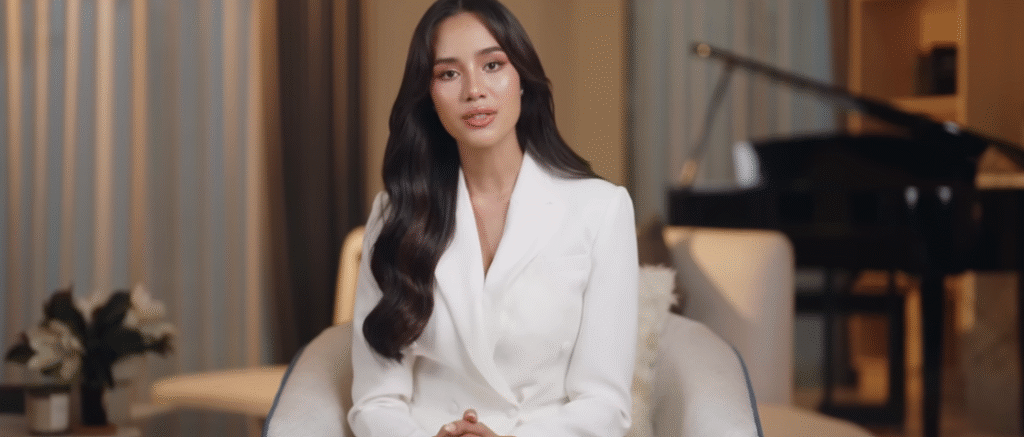Opal Suchata – Personal and Career Details
| Category | Information |
|---|---|
| Full Name | Suchata Chuangsri |
| Nickname | Opal |
| Date of Birth | 20 September 2003 |
| Age | 21 (as of 2025) |
| Birthplace | Phuket, Thailand |
| Height | 1.80 m (5 ft 11 in) |
| Hair Color | Black |
| Education | Politics & International Relations, Thammasat University |
| Pageant Titles | Miss Universe Thailand 2024, Miss World 2025 |
| Languages | Thai, English, Chinese |
| Advocacy | “Opal For Her” – Breast Cancer Awareness |
| Notable Surgery | Benign breast lump removal at 16 |
| @suchaaata | |
| Reference | wikipedia.org/wiki/Suchata_Chuangsri |

Opal Suchata exuded strength, poise, and a clear sense of purpose as she stood in front of the cameras to accept her Miss World 2025 title. Wearing a gown that glistened in the spotlight, she transcended her role as a beauty queen and became a symbol of tenacity. She received a shocking diagnosis at the age of 16: she had breast tumors that were 10 centimeters in size. Naturally terrifying for a teenager, the event turned out to be a crucial turning point that would later influence her activism and career.
She might have become withdrawn or insecure as a result of having surgery at such an early age. Rather, it pushed her toward a cause she would pursue with remarkable tenacity. That surgery was strictly medical, despite the fact that ignorant voices on the internet frequently misclassify it as cosmetic. It served as the cornerstone of the “Opal For Her” campaign, which aimed to inform people about early detection, self-examinations, and the value of paying attention to one’s body rather than drawing attention to her personal suffering.
The discussion about Opal’s appearance has heated up over the last few months. Comparisons of before and after images are common on social media, which feeds rumors about plastic surgery. Even in comments, the phrase “Miss Plastic Surgery” has become popular, frequently with no context. Unlike many public figures, however, who choose to keep quiet about such rumors, Opal chooses to be transparent. She clearly flips the narrative by discussing her surgery in public and framing it through her advocacy.
Her candor has struck a chord, especially with young women in Southeast Asia. Opal’s voice has become particularly innovative in areas where cultural taboos often surround healthcare discussions, normalizing health issues while rejecting shame. She frequently gives speeches at events, frequently with medical experts, promoting a message that is both emotionally and medically sound.
Opal’s story merits a different perspective, even though comparisons between public figures and their aesthetics are frequently made. This is more than just a change in appearance. It’s a tale of medical survival combined with an exceptionally successful outreach initiative that unites fashion and healthcare. Her appearance—sleek poses, well-applied makeup, flowing dresses—does not take away from her genuineness. They back her ability to raise awareness of problems that are frequently ignored.
She provided an incredibly clear reflection, for example, in a televised interview a few days after winning Miss World: “That surgery didn’t take anything from me—it gave me something.” A mission. More than any denial, the comment put a stop to rumors. Additionally, it changed the focus of the public discourse from cosmetics to community impact.
Opal’s ability to use platforms based on beauty to address subjects that are frequently disregarded in those same settings is what makes her journey so captivating. She does not avoid being glamorous. Instead, she carefully incorporates it, utilizing her photo shoots, media appearances, and even pageant Q&A sessions to spread significant messages. Her academic training in political science and international relations has significantly enhanced this communication style.
By means of strategic partnerships with educational institutions, hospitals, and online platforms, her campaign is emerging as a model for celebrity-driven health advocacy. Opal is changing the perception of pageantry by fusing personal experience with public service, moving away from superficial presentation and toward leadership based on substance.
It’s interesting that her critics frequently ignore this broader background. They eliminate the emotional depth of her physical journey by focusing only on unconfirmed surgical rumors. However, her supporters are more resistant to deception, particularly those in Thailand and the surrounding countries. They can see how emotionally invested she is in her success. They witness a young lady who overcame adversity and achieved success.
She also joins an increasing number of contemporary title holders who use their own struggles to provoke more meaningful discussions. Opal serves as a reminder that beauty titles can provide much more than just awards and dresses, much like Priyanka Chopra’s mental health initiatives or Catriona Gray’s HIV advocacy. Through empathy, they can rethink leadership, inspire young people, and magnify messages.
Crucially, Opal’s story has also spurred more general conversations about body agency and surgical transparency. Her candor has been especially refreshing at a time when cosmetic procedures are becoming more and more commonplace. Rather than being bashful, she emphasizes the medical necessity of her procedure, setting it apart from elective surgery while still honoring people who have different preferences. Her public persona gains more emotional depth and relatability as a result of this multi-layered story.
Did Opal Suchata have plastic surgery for cosmetic reasons?
No. Her surgery at 16 was for medical purposes—to remove benign tumors from both breasts.
What is the “Opal For Her” campaign?
It’s a breast health awareness initiative launched by Opal, aimed at promoting early detection and education for women.
Has she addressed plastic surgery rumors directly?
While she hasn’t commented on cosmetic procedures, she has been transparent about her breast surgery and its role in her advocacy.
Why is her surgery being discussed so much?
Her transformation and visibility have led to public speculation, but the actual procedure was medically necessary and documented.
How did her surgery influence her career?
It motivated her to become an advocate for women’s health, using pageantry as a platform for change.
Does she promote body positivity?
Yes. She regularly encourages women to prioritize health, self-awareness, and education over appearance-based judgment.
What message does she send through her campaign?
That early detection saves lives, that medical struggles shouldn’t be hidden, and that confidence comes from ownership—not perfection.
How has public response been to her story?
While some online voices focus on her looks, many have praised her honesty, strength, and impactful messaging.
Are there photos showing her transformation?
Yes, but none officially released by Opal. Her emphasis remains on health, not aesthetics.
Is she continuing advocacy during her Miss World reign?
Absolutely. Her campaign work has expanded internationally, and she remains deeply committed to the cause.
